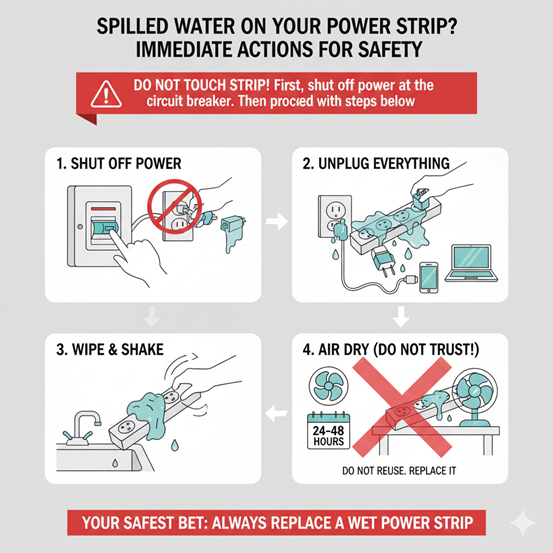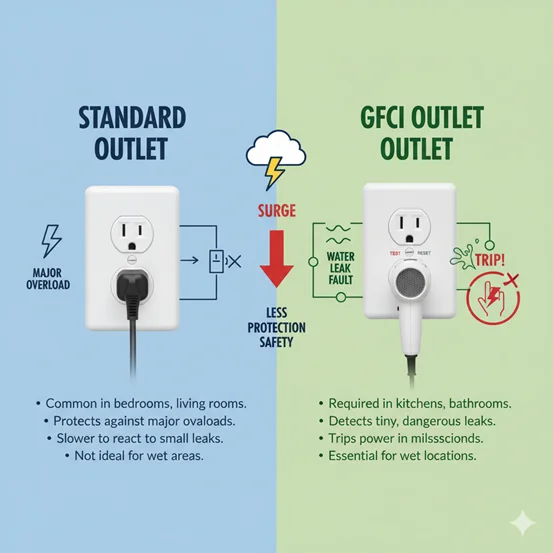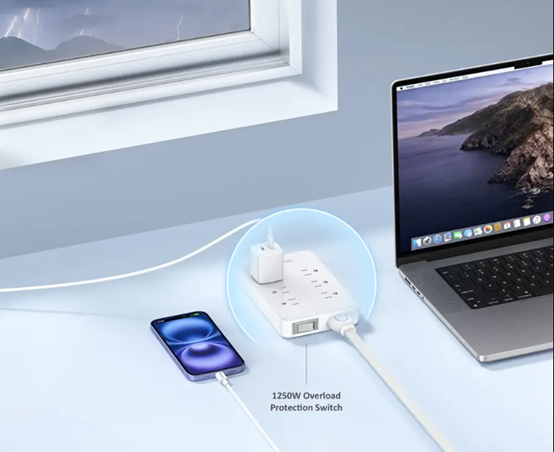Spilling water on a surge protector power strip creates an immediate and serious safety risk. In some cases, water drops on electrical outlets can lead to short circuits, permanent damage to your electronics, electric shock, or even a fire.
Your immediate actions are critical. Panic can lead to dangerous mistakes, so knowing the correct procedure is essential for handling the situation safely.
This guide provides a straightforward, step-by-step plan for what to do after a spill. We will cover the immediate safety precautions, explain the hidden risks of using a “dried-out” power strip, and outline the best way to protect your home and devices moving forward.
- Disconnect Power Immediately: Your first and most critical action is to safely cut all power to the wet surge protector at the circuit breaker before touching anything. This eliminates the immediate risk of electric shock.
- A “Dry” Power Strip Isn’t Safe: Internal moisture can remain for days, causing corrosion and short circuits that create a fire hazard long after the initial spill.
- Replacement is Non-Negotiable: A surge protector power strip that has been exposed to water is permanently compromised. It must be discarded and replaced to ensure safety.
- Invest in Certified Safety: High-quality power strips with modern safety features are a necessary investment for protecting both your expensive electronics and your home from electrical faults.
- Use Layered Protection: For the best defense, a whole-house surge protector should be your primary safeguard, with high-quality plug-in protectors like those from Huntkey providing a final layer of security for sensitive devices.
Your First Steps After Spilling Water on Your Power Strip
When you’re dealing with a wet surge protector power strip, your actions in the first few minutes are the most important for ensuring safety. Follow these steps precisely and in order.
Warning — Do not touch the strip. Your first and only immediate action should be to go to your home’s electrical panel (breaker box) and shut off the circuit that powers that outlet. Only after the power is completely off is it safe to handle the power strip and connected devices.
Once you are certain the power is off, proceed with these steps:
Step 1: Disconnect Power and Unplug Everything
Safety is the absolute priority. With the circuit breaker off, you can now safely unplug the surge protector power strip from the wall outlet.
After that, carefully remove each plug connected to the power strip. Place your electronic devices and their chargers aside and check their plugs for any moisture. If a plug is wet, do not use it until it is thoroughly dry. This situation is similar to when you get water in a charging port—any dampness can cause a short circuit.
Step 2: Remove Visible Water from the Power Strip
Take the unplugged power strip to a dry area. Use a dry microfiber cloth or paper towel to wipe down the entire exterior, including the cord and the casing.
Next, gently tilt and shake the power strip to help drain any water that may have entered the outlet slots or seams. While this can help, it is not a complete solution. You can’t see what’s happening inside.
Step 3: Let It Dry (But Don't Trust It)
Place the power strip in a well-ventilated area to air dry for at least 24 to 48 hours. Some might suggest using a fan to speed up the process, similar to trying to figure out how you can dry a charging port faster.
This step is for temporary safety only. Even after 48 hours, there is no guarantee that the power strip is safe to use. Internal components can hold onto moisture, and minerals left behind by tap water can create conductive pathways or cause corrosion. The strip is now compromised, which leads us to the hidden dangers you can’t see.

Why "Dry" Doesn't Mean Safe
You’ve unplugged the power strip, wiped it down, and let it sit for a couple of days. It looks perfectly fine. You might persuade yourself that it’s totally fine to plug it back in, but this is where a small mishap can turn into a major hazard.
We wouldn’t recommend reusing the surge protector that had been exposed to liquid.
No matter how long it has been left to dry. The internal components are permanently compromised, creating a serious fire and shock risk.
Internal Corrosion and Mineral Deposits
When you spill water on electronics, two things happen that you can’t see:
- Trapped Moisture: The complex internal assembly of a power strip, with its tight spaces and soldered components, traps water deep inside. While the outside feels dry, moisture can remain internally for days or even weeks.
- Conductive Residue: Tap water isn’t pure. It contains minerals like salt and calcium. When the water evaporates, it leaves these mineral deposits behind on the circuitry. This residue is conductive and can create tiny new pathways for electricity to flow, leading to short circuits.
Over time, this trapped moisture and residue will corrode the metal contacts and wiring. This corrosion weakens electrical connections, which generates excess heat—a primary cause of electrical fires.
The Outlet Safety Net: Regular vs. GFCI Outlets
Not all wall outlets offer the same level of protection, especially when it comes to the dangerous mix of water and electrical outlets.
- A Standard Outlet: Most outlets in bedrooms, living rooms, and offices are protected by a standard circuit breaker. This breaker is designed to trip during a major power overload (like running a vacuum and a space heater at once) or a direct short circuit. It is not sensitive enough to detect the small, dangerous current leaks caused by moisture inside a power strip.
- A GFCI Outlet: A Ground Fault Circuit Interrupter (GFCI) is a “smart” outlet, usually found in kitchens, bathrooms, and garages. It’s designed specifically to detect tiny variations in electrical current—like those caused by water—and will shut the power off in milliseconds, long before a standard breaker would react.

If your power strip was plugged into a standard outlet, it likely wouldn’t trip the breaker after a spill. This means the compromised, corroding device could remain energized, silently waiting to fail. This is a risk you should never take.
The Most Recommended Practice: Replace the Power Strip, Don't Reuse!
The water-intruded Surge protector power can fail silently for days or weeks after the incident. The only safe and responsible action is to discard it and invest in a high-quality replacement.
What kind of surge protector should I buy to replace my damaged one?
- High joule rating (over 1,000 joules for electronics)
- Certified to meet safety and compliance standards like ETL and FCC.
- Integral copper bar and flame-retardant casing
- Boasts multiple protection, including Surge Protection, Overload Protection, Over Voltage Protection, Short-Circuit Protection…
Prioritize reputable brands that focus on safety and quality components over generic, low-cost power strips.
Huntkey power strips are designed for the utmost security and charging efficiency, giving you a reliable defense for your home and office.
For Solid, Everyday Protection: Huntkey SZC514
Best for living rooms, bedrooms, kitchens, and common areas where safety around children and pets is a top priority. This is a durable, reliable all-rounder.

For Solid, Everyday Protection
Each outlet is equipped with an internal safety shutter, a critical feature that helps prevent children from inserting foreign objects.
The body is constructed from high-quality, fire-retardant material to prevent a potential electrical failure from becoming a fire hazard.
A one-piece copper bar internal design ensures better conductivity and less heat buildup for enhanced safety and a longer lifespan.
With a built-in protection system that can minimize the risk of power surge, overload, over-voltage, short circuit, and more.

For the Home Office or Entertainment Center
Each outlet is equipped with an internal safety shutter, a critical feature that helps prevent children from inserting foreign objects.
This internal design provides stable and secure power to all outlets, minimizing the risk of overheating common in cheaply made strips.
A robust power cord provides durability and safety.

For Custom Setups & Modern Spaces
Each module is built with durable, flame-retardant materials for enhanced safety and reliability.
both 6S and 3S are ETL-listed, and come with overload protection. Easycombo 6S is a surge protector power strip, and thus more ideal for home and office use.
Easycombo 3S is designed specifically for cruise ships. This power strip meets cruise line regulations by not having surge protection, making it safe and approved for onboard use.
The customizable design with detachable power cords helps you organize cables more effectively, which can be a key safety benefit in households with active children or pets who might snag loose wires.
Pro’s Suggestions: Set up Whole-House Protection Backed up by Plug-In Surge Protectors
While a high-quality plug-in surge protector is essential, it’s important to understand its role in a complete home safety strategy.
Plug-in surge protectors are a crucial final line of defense, but they are not designed to block the massive voltage from a nearby lightning strike or a major power grid failure.
For comprehensive safety, experts recommend a two-layer system:
- The First Line of Defense: Whole-House Surge Protection. This is a heavy-duty unit that an electrician installs directly at your main electrical panel. Its job is to stop or reduce powerful external surges before they enter your home’s wiring, protecting everything from your outlets to your major appliances.
- The Final Line of Defense: Plug-In Surge Protectors. After the whole-house unit has blocked the initial massive surge, a smaller amount of excess voltage can still get through. A high-quality surge protector power strip at the outlet absorbs this residual energy and also protects your devices from smaller surges generated inside your home (e.g., when a large appliance cycles on).
That is to say, the whole-house protector is the main gate to your castle, and your high-quality plug-in protectors are the guards at the doors of your most important rooms.
At Huntkey, We Never Compromise Home Power Safety
When it comes to a surge protector power strip that has been exposed to water, there is no room for doubt or risk.
Don’t wait for a dangerous failure to happen. Make the safe choice today.
[Click to Explore Huntkey’s Full Range of Safe and Reliable Power Solutions]
Quick Link
- Home
- About Us
- Partnership
- Industrial PSU
- Privacy Policy
- Sitemap




